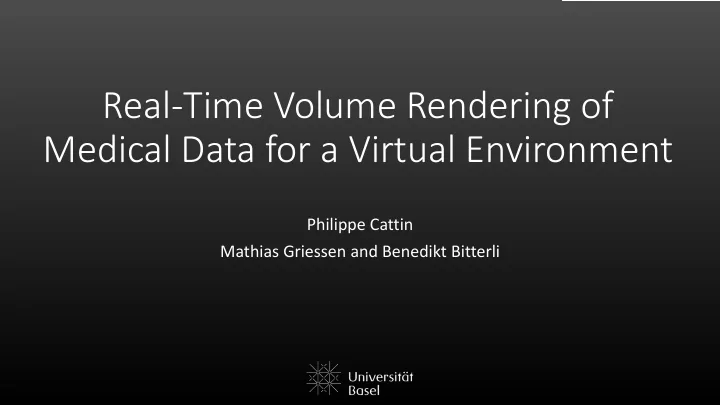

Real-Time Volume Rendering of Medical Data for a Virtual Environment Philippe Cattin Mathias Griessen and Benedikt Bitterli
Motivation
Thousands of years ago [Prof. Alt, Uni Basel]
Some history New stone age (10’000 B.C.) Middle age Today
Why Laser?
Functional cuts
Bone cut with a saw
Bone cut with our laser
Why still spend hours/days to segment data sets?
Solution?
Volume Rendering Basics
Volume Rendering: Why? Pros Cons • High quality images • Computationally complex • No manual input • In VR difficult • Difficult scene renderer to embed polygonal objects
Classes of Volume Rendering Algorithms Ray casting method Plane Composing (Object order algorithms) (Image order algorithms) • Basic ray-casting • Basic slicing with 2D textures • Using octrees • Shear-warp factorization • Translucent textures with image- aligned 3D textures
Basic Forward Ray-Casting
Transferfunction • Transparency • Color • Emissivity
Challenges • 1 Million Triangles • Is considered a big mesh • 1 Million Voxels • Is considered small (100x100x100) • Typical size 512x512x500
Design Choices • Interpolation method • Trilinear • Sampling method • Less in the peripheri • Step size along the ray • Adaptive using distance map • Early stopping
Difficult Cases
• Fluffy objects • Lots of air
Distance Map • Precalculated on GPU • Size of map ¼ x ¼ x ¼ • Closest pixel (according to the transferfunction) spherically
Shadows
Occlusion map • Pre-calculated on GPU • Size of map 1/4x1/4x1/4 • 32 different directions • Environmap either • Static HDR image • Dynamic lamp (Gaussian) • Time for each image on GPU [3ms] • Special case when volume is rotated/scaled
Fusion with Mesh Objects
Example Video
Video
Conclusion • Volume Rendering for VR is possible • Mainly thanks to • Modern GPU hardware • Modern VR glasses • Clever programming Soon demo app: https://www.diffuse.ch
Recommend
More recommend